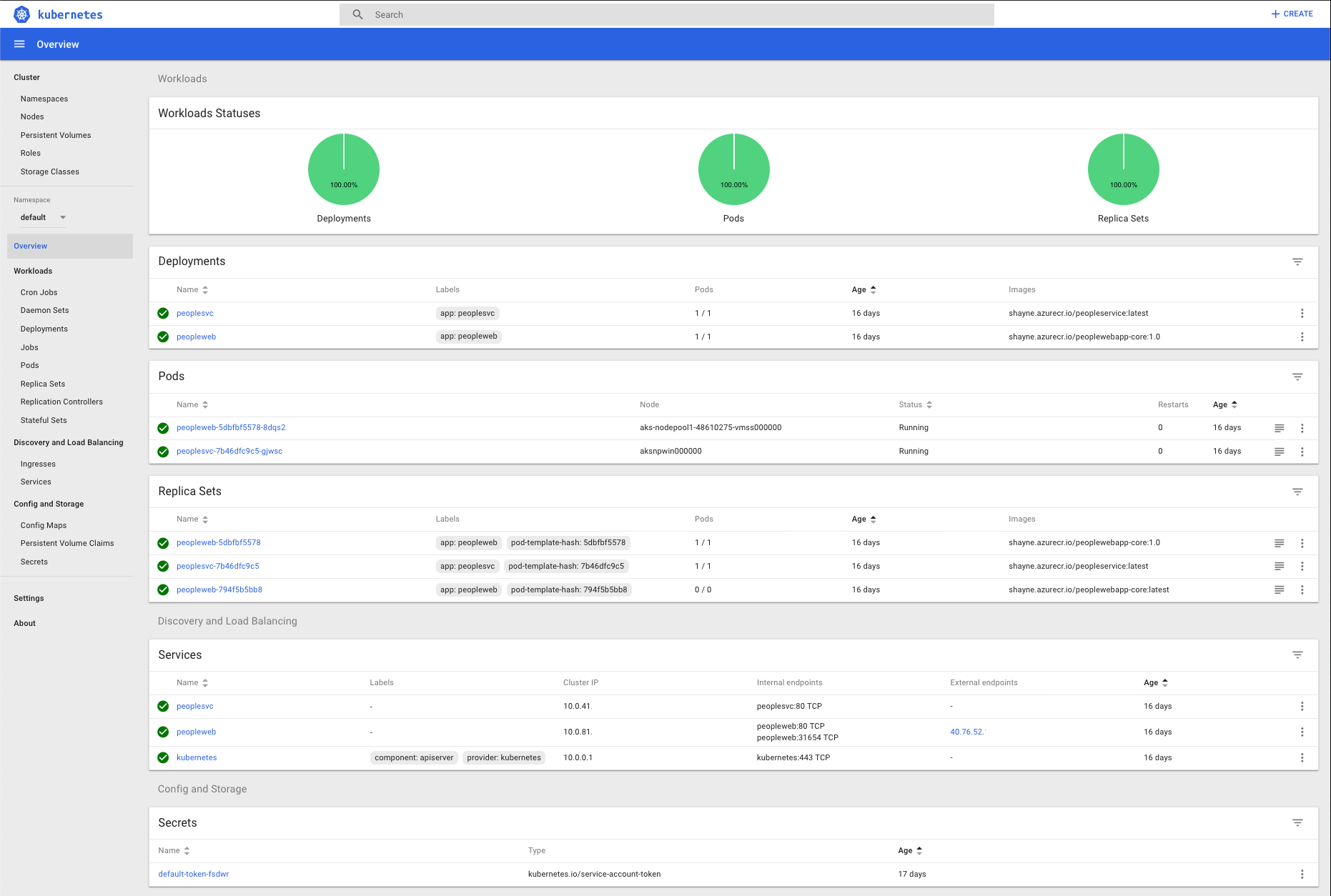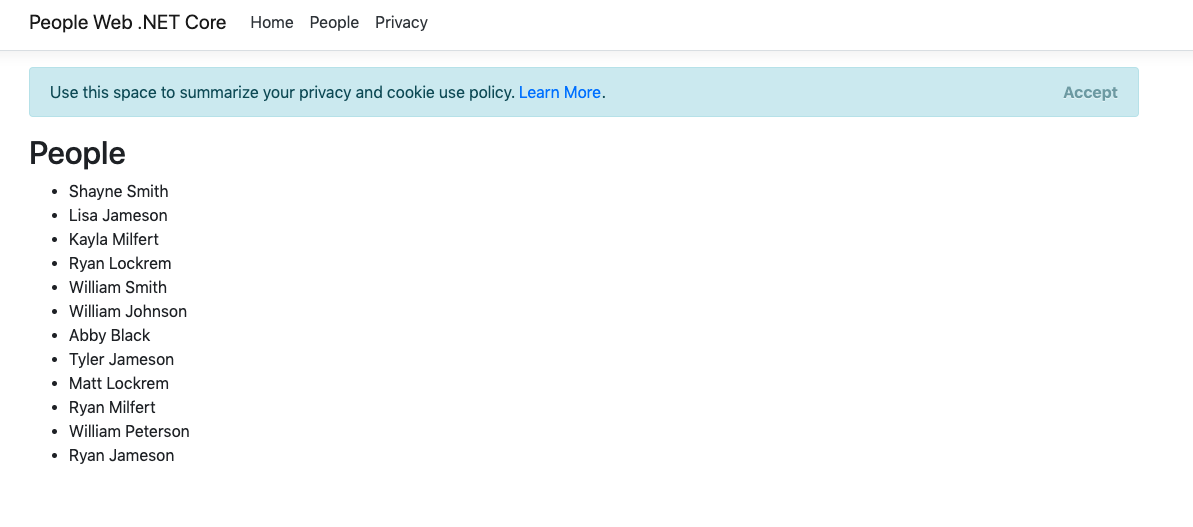In my previous post, I showed how to take a WCF service and containerize it using Visual Studio. By doing so, this gives us the opportunity to push our heritage (aka legacy) application to the cloud either in Azure App Service using Web App for Containers, Azure Container Instances (ACI), or in the event we need something like an orchestrator Kubernetes is available in AKS.
Many times we would like to use the new technology with the old. For instance, creating a .NET Core Razor Pages application or .NET Core Web API to consume the WCF application.
However, the new applications will be using Linux containers and everything must be scalable and run in a Kubernetes cluster.
Let's see how we can use AKS with the new Windows Container support to accomplish this!
Setting up the Windows enabled AKS Cluster

NOTE: please read related docs, there are some Before you begin items that are important to have set up.
Create the cluster
A couple of notes here is you must create the cluster using the Azure Network plugin (Azure CNI) as well as a Windows Admin Password for any Windows Server Containers created on the cluster.
GROUP="demo-aks"
CLUSTER_NAME="demo-cluster"
# user and password needed for the Windows nodes if we create a Windows node pool
PASSWORD_WIN="P@ssw0rd1234"
USER_WIN="azureuser"
az group create -l eastus -n $GROUP
#create the aks cluster
az aks create \
--resource-group $GROUP \
--name $CLUSTER_NAME \
--node-count 1 \
--enable-addons monitoring \
--kubernetes-version 1.14.0 \
--generate-ssh-keys \
--windows-admin-password $PASSWORD_WIN \
--windows-admin-username $USER_WIN \
--enable-vmss \
--network-plugin azure
The script creates a single node and master controller, all Linux. From here we can now add the Windows node pool for the WCF Service.
# create the windows node pool
az aks nodepool add \
--resource-group $GROUP \
--cluster-name $CLUSTER_NAME \
--os-type Windows \
--name npwin \
--node-count 1 \
--kubernetes-version 1.14.0
After the new Windows node pool is creates, kubectl get nodes shows Ready for deployments.
NAME STATUS ROLES AGE VERSION
aks-nodepool1-48610275-vmss000000 Ready agent 10m v1.14.0
aksnpwin000000 Ready agent 110s v1.14.0
Deploy the applications
In order for proper deployment to the Windows node pool, specify a nodeSelector in the spec of your chart.
spec:
nodeSelector:
"beta.kubernetes.io/os": windows
Here is a sample of the deployment file for the PeopleService WCF example I'll use and have already containerized and pushed to my Azure Container Registry.
When you're using Azure Container Registry (ACR) with Azure Kubernetes Service (AKS), an authentication mechanism needs to be established. See Authenticate with Azure Container Registry from Azure Kubernetes Service documentation on how to enable.
apiVersion: apps/v1
kind: Deployment
metadata:
name: peoplesvc
labels:
app: peoplesvc
spec:
replicas: 1
template:
metadata:
name: peoplesvc
labels:
app: peoplesvc
spec:
nodeSelector:
"beta.kubernetes.io/os": windows
containers:
- name: peoplesvc
image: shayne.azurecr.io/peopleservice:latest
ports:
- containerPort: 80
selector:
matchLabels:
app: peoplesvc
---
apiVersion: v1
kind: Service
metadata:
name: peoplesvc
spec:
type: ClusterIP
externalName: peoplesvc
ports:
- protocol: TCP
port: 80
selector:
app: peoplesvc
The Service type is set to ClusterIP here so only an internal IP is allocated. Next, a .NET Core Razor Pages application is deployed in a Linux container to the Linux pool.
Same is true, container pushed to ACR. Following chart is the deployment file for the web application.
apiVersion: apps/v1
kind: Deployment
metadata:
name: peopleweb
labels:
app: peopleweb
spec:
replicas: 1
template:
metadata:
name: peopleweb
labels:
app: peopleweb
spec:
nodeSelector:
"beta.kubernetes.io/os": linux
containers:
- name: peopleweb
image: shayne.azurecr.io/peoplewebapp-core:latest
env:
- name: "SERVICE_URL"
value: "peoplesvc"
ports:
- containerPort: 80
selector:
matchLabels:
app: peopleweb
---
apiVersion: v1
kind: Service
metadata:
name: peopleweb
spec:
type: LoadBalancer
ports:
- protocol: TCP
port: 80
selector:
app: peopleweb
Notable points.
- ENV variable : SERVICE_URL used for the application to communicate with the WCF service. Notice that it is a DNS name.
- Service type: LoadBalance allocating a public IP address for external access.
The web app to service calls via DNS is made possible via Azure virtual network enabled by Azure CNI.

Deploy the applications, use the following command.
kubectl apply -f people.web.yaml -f people.wcf.yaml
Once the deployment is complete, kubectl get all shows:
NAME READY STATUS RESTARTS AGE
pod/peoplesvc-7b46dfc9c5-gjwsc 1/1 Running 0 1d
pod/peopleweb-5dbfbf5578-8dqs2 1/1 Running 0 1d
NAME TYPE CLUSTER-IP EXTERNAL-IP PORT(S) AGE
service/kubernetes ClusterIP 10.0.0.1 <none> 443/TCP 1d
service/peoplesvc ClusterIP 10.0.41.1** <none> 80/TCP 1d
service/peopleweb LoadBalancer 10.0.81.1** 40.**.52.*** 80:31654/TCP 1d
NAME READY UP-TO-DATE AVAILABLE AGE
deployment.apps/peoplesvc 1/1 1 1 1d
deployment.apps/peopleweb 1/1 1 1 1d
NAME DESIRED CURRENT READY AGE
replicaset.apps/peoplesvc-7b46dfc9c5 1 1 1 1d
replicaset.apps/peopleweb-5dbfbf5578 1 1 1 1d
replicaset.apps/peopleweb-794f5b5bb8 0 0 0 1d
Further details are available in the Kubernetes dashboard via az aks browse --name <clustername> --group <resource-group>

Browsing to the site https://ipaddress/People

Summary
This is a great scenario and solution for anyone looking to use the new technologies while also having an opportunity to move legacy heritage application to the cloud and orchestration the entire architecture. Scaling, DevOps, containers and more cloud native practices are leveraged in new and old.
